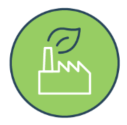Insight
Austria’s industrial landscape, with a focus on steel, cement, and chemicals, plays a vital role in the nation’s economy and decarbonisation journey. Guided by its ambitious Climate and Energy Strategy, Austria aims to achieve climate neutrality by 2040, a target supported by initiatives such as the Mission Innovation Austria Initiative. The industrial sector is actively transitioning toward lower emissions, driven by innovative projects that integrate renewable hydrogen and advanced carbon capture technologies.
Industry GHG Emissions
In 2022, greenhouse gas emissions from Austria’s energy sector, specifically stationary fuel combustion for manufacturing industries and construction, amounted to an estimated 22.4 million tonnes CO2-equivalent. The steel industry was the primary contributor to these emissions, followed closely by cement production and chemical manufacturing. Emissions from industrial processes accounted for an additional 12 million tonnes CO2-equivalent, with cement and lime production representing the largest share at 6 million tonnes. Steel manufacturing and ammonia production were other significant contributors to industrial process emissions.
Sectors Overview
Austria’s industrial activity is concentrated in key regions such as Linz, Leoben, and Styria, which host major hubs for steel, cement, and chemical production. The steel sector is central to Austria’s economy, driven by advanced manufacturing processes and international trade. Similarly, cement production is a cornerstone of the construction industry, supported by cutting-edge technologies and a skilled workforce. The chemical sector underpins a range of downstream industries, including pharmaceuticals and advanced materials, ensuring its strategic importance in Austria’s industrial ecosystem.
Economic Relevance of Key Sectors
Chemicals & Refining
Annual net turnover (2021):
€16.9 billion
Number of employees (2021):
88,800
Export quota (approx.):
33%
Biggest companies based on turnover:
Borealis AG, Henkel Central Eastern Europe GmbH, Lenzing AG
Industry hotspots:
Upper Austria, Vienna region
Metals Including Iron and Steel
Annual net turnover (2021):
€8.6 billion
Number of employees (2023):
15,601
Main export markets:
Germany, US, France, Italy, Switzerland
Export quota (2023):
80%
Biggest companies based on turnover:
voestalpine AG, Blum Group Holding GmbH, Plansee Holding AG, Amag AG
Industry hotspots:
Linz, Donauwitz-Leoben
Cement & Lime
Annual net turnover (2018):
€0.43 billion
Members of the AT cement association:
1,200
Biggest companies based on turnover:
Leyer + Graf BaugmbH, Ing. Hans Bodner BauGmbH & Co. KG, Baumit GmbH, Franz Oberndorfer GmbH & Co. KG
Knowledge Sharing and R&D Capabilities
Austria has positioned itself as a leader in industrial innovation, with dedicated platforms such as the Mission Innovation Austria Initiative promoting collaboration between industry, academia, and government. The Austrian Research Promotion Agency (FFG) supports research and development projects focused on industrial decarbonisation, while partnerships with institutions like the Vienna University of Technology provide cutting-edge insights into low-carbon technologies. These collaborations facilitate knowledge transfer and accelerate the adoption of innovative solutions across the industrial sector.
Decarbonising Industry – Funding Opportunities
Austria offers robust funding mechanisms to support industrial decarbonisation. The Climate and Energy Fund provides significant financial backing for pilot and demonstration projects in areas such as renewable hydrogen, energy efficiency, and carbon capture utilisation and storage (CCUS). The Green Investment Fund, launched in partnership with the European Investment Bank, allocates resources to decarbonisation projects across heavy industry. Total funding volumes for these initiatives exceed €1.5 billion annually, demonstrating Austria’s commitment to climate innovation.
Relevant Policies and Roadmaps
Austria’s Climate and Energy Strategy serves as the cornerstone of its industrial decarbonisation efforts, outlining pathways to reduce emissions and achieve climate neutrality by 2040. Policies such as the Renewable Energy Expansion Act provide incentives for integrating renewable energy into industrial processes. Additionally, the National Hydrogen Strategy promotes the adoption of green hydrogen across high-emission sectors, including steel and chemical production. Austria’s comprehensive policy framework aligns with EU climate goals while addressing the unique challenges of its industrial base.
Flagship Projects
Austria is at the forefront of industrial decarbonisation with several flagship projects. At Voestalpine’s steelworks in Linz, a pilot project is underway to replace coal with renewable hydrogen in blast furnaces, significantly reducing emissions. The Lafarge cement plant in Mannersdorf has implemented advanced carbon capture technology, aiming to store and repurpose captured CO2. In the chemical sector, the OMV Schwechat refinery is transitioning to low-carbon production methods, supported by investments in renewable energy and efficiency improvements. These projects highlight Austria’s innovative approach to achieving climate neutrality in its industrial sectors.

